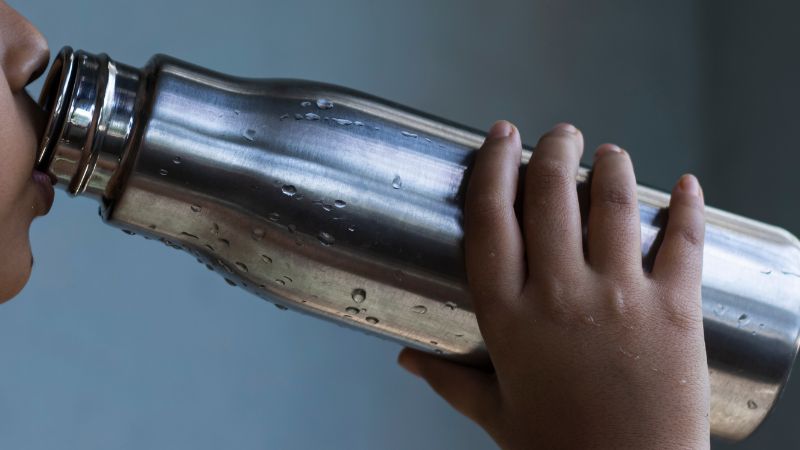
Gym Essentials For Women:A Complete List
Enthusiasts who never miss a session, understanding the gym essentials for women is crucial, not just for what to wear but also for what to

When it comes to reusable water bottles, you have several choices: glass, plastic, or stainless steel. The question that arises is: which option is the best, and are they all safe for use?
It is crucial to comprehend why we must reconsider our reliance on single-use water bottles. To be precise, single-use plastic bottles pose a significant environmental threat. In the United States alone, we consume 70 million bottles every day! (Container Recycling Institute)
Although the increase in water consumption is commendable, the use of plastic bottles has led to an environmental crisis. A mere 29% of plastic bottles in the US are recycled, while the rest find their way into landfills, water bodies, and oceans.
The most effective way to mitigate this problem is by opting for reusable containers for our water needs. Utilize glassware at home and opt for reusable bottles while on the go.
Investing in a reusable water bottle is a necessity.
The primary concern associated with plastic reusable bottles is their inherent plastic nature. Eventually, when you grow tired of them, they become too soiled, or they develop cracks, you’ll have to dispose of them. This leads to the introduction of yet another plastic bottle, which is often thicker than single-use ones, thereby compounding the disposal challenge.
These bottles share the same fundamental problem as single-use ones – they require recycling. If you’re fortunate, your local community effectively recycles plastic.
“Some materials are recycled at relatively high levels: more than two-thirds of paper and about a third of aluminum. But for plastic, the rate is just eight percent. Another 16 percent is incinerated. The vast majority of plastic — that remaining 76 percent — ends up in landfills.” – PBS
Despite potentially enjoying months or even years of usage from a plastic reusable water bottle, it still runs the risk of ultimately ending up in a landfill.
Moreover, it’s essential to note that plastic bottles are not suitable for hot liquids, as they may release chemicals when exposed to heat.
For further insights into the comparison between plastic and stainless steel bottles, you can explore this article, click here.
Glass reusable water containers also pose challenges.
Even though glass can be completely recycled, nearly all glass bottles available in stores are covered in plastic for protection. This is because glass is prone to breaking easily.
And that’s the additional challenge. A single accidental drop, and your bottle shatters on the floor. Now you have broken glass to dispose of and a plastic covering that is likely not suitable for recycling.
Aluminum bottles also fall short as a favorable option.
To prevent acidic liquids from extracting harmful substances from the aluminum, many of these bottles feature an inner lining made of plastic or epoxy resin. Some of these linings contain BPA or other detrimental chemicals.
Although aluminum itself is recyclable, the resin or plastic lining usually goes unrecycled. Instead, it is more likely to be incinerated or, worse yet, find its way into the water supply.
In all these instances, there may be differing opinions regarding each water bottle type. However, there appears to be unanimous consensus that stainless steel water bottles represent a superior, safer, and more environmentally responsible choice.
Premium stainless steel reusable water bottles offer the solution.
Firstly, they are endlessly recyclable. The following are some of the environmental impacts and benefits of stainless steel water bottles.
“The benefits of stainless steel recycling are clear—it’s good for the environment, and it makes efficient use of raw materials while saving money. It uses less energy than new metal production, and steel can be recycled over and over again.” – The Advantages and Disadvantages of Stainless Steel Recycling and Reuse
Secondly, a stainless steel bottle can withstand dents and more. Not only are they long-lasting, but they also remain functional even when subjected to damage.
Thirdly, you can utilize your stainless steel bottle for hot liquids, in addition to cold ones. Given that stainless steel is food-grade, you can even employ it for brewing and storing tea.
100% yes. Without a doubt.
By utilizing 18/8 or #304 stainless steel, specifically food-grade stainless steel, it becomes entirely safe. There is no risk of chemical or mineral leaching.
The crucial factor is ensuring that you exclusively invest in the highest quality stainless steel.
In contrast to plastics, which can release harmful chemicals in even minuscule amounts, stainless steel remains impervious to such issues.
Cleaning it is also a breeze. As anyone who has ever cleaned a stainless steel pan can attest, a bit of soap renders the steel perfectly spotless.
Due to its sterile nature, stainless steel inhibits the growth of mold and mildew. Those who have owned plastic or glass water bottles are familiar with the tendency for mold and mildew to flourish on them. Stainless steel eliminates this entirely.
As mentioned earlier, unlike other bottle materials, minor damage like dropping your bottle during a hike or acquiring a dent won’t harm it.
Since stainless steel is inert, there is no need for a plastic lining. Safer and free from the need for plastics, stainless steel undeniably stands out as the superior choice.
18/8 stainless steel, also known as 304-grade stainless steel, consists of 18% chromium, 8% nickel, less than 0.8% carbon, and a minimum of 50% iron.
The presence of chromium prevents oxygen from binding with the iron, thereby preventing rust or oxidation.
To ensure you’re getting a top-quality product, it’s essential to seek out 18/8 or 304-grade stainless steel. This is the same stainless steel used in high-quality pots and pans.
This type of stainless steel is known for its durability and longevity, remaining in excellent condition for many years without degradation.
Opting for reusable water bottles is a commendable departure from the use of disposable ones.
While any transition toward sustainability is a positive stride, stainless steel stands out as the superior option for water bottles, known for their durability, resilience in challenging conditions, and complete recyclability.
Explore our website for options such as the H2O Reminder Smart Water Bottle.
Are all stainless steel water bottles safe?
Not all stainless steel water bottles are created equal. The safety of a stainless steel water bottle depends on the grade of stainless steel used. Look for bottles made from 18/8 stainless steel (also known as 304-grade stainless steel) for maximum safety.
This grade is known for its resistance to corrosion and leaching of harmful substances. Be cautious when purchasing cheaper, lower-quality stainless steel bottles, as they may not meet the same safety standards.
Are stainless steel water bottles safe during pregnancy?
Stainless steel water bottles made from high-quality materials like 18/8 stainless steel are generally considered safe for use during pregnancy. They do not contain harmful chemicals like BPA or phthalates, which can be a concern with some plastic bottles.
You may also want to know: What Does BPA Free Mean In Water Bottles
However, it’s always a good idea to check the specific product label and manufacturer information to ensure that the bottle is free from any potentially harmful substances. If you have any specific health concerns during pregnancy, it’s advisable to consult with a healthcare professional for personalized guidance.


Enthusiasts who never miss a session, understanding the gym essentials for women is crucial, not just for what to wear but also for what to

A common myth circulating in the fitness world is the belief that a gym diet plan is unnecessary. Many seem convinced that they can simply

The average bench press, often referred to humorously in gyms as ‘How much ya bench’ or ‘whaddaya bench?’, stands as a quintessential measure of strength

Nowadays, we always seem to be packing a bag for something. Whether it’s getting ready for work with your messenger bag or briefcase, filling up

Enthusiasts who never miss a session, understanding the gym essentials for women is crucial, not just for what to wear but also for what to

A common myth circulating in the fitness world is the belief that a gym diet plan is unnecessary. Many seem convinced that they can simply

The average bench press, often referred to humorously in gyms as ‘How much ya bench’ or ‘whaddaya bench?’, stands as a quintessential measure of strength

Nowadays, we always seem to be packing a bag for something. Whether it’s getting ready for work with your messenger bag or briefcase, filling up
Copyright © 2025 remindsmartbottles. All Rights Reserved.
Copy the coupon code below and fill it in when you purchase to enjoy!
newuser